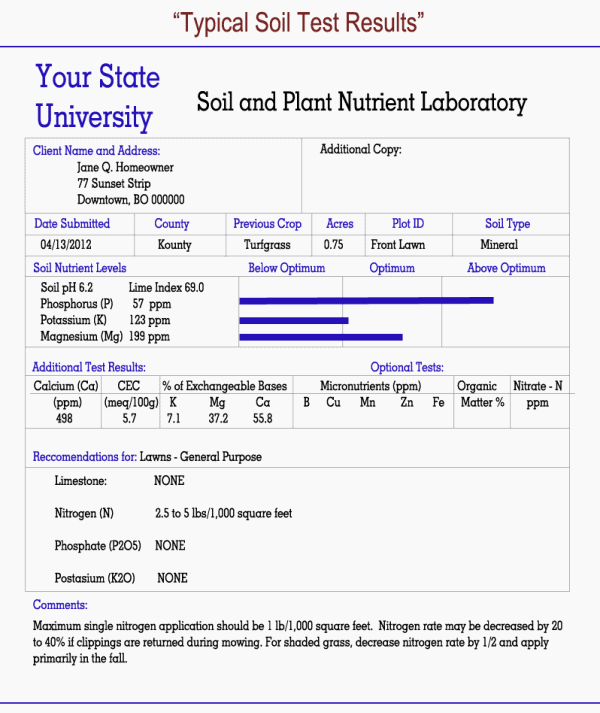Below, you will find a "Typical Soil Test Results" form.
I can guarantee you that any such report that your
receive from a private company or your particular state's land
grant university will be different! It will be arranged
differently and may contain more or less information
than the form presented here.

However, there will be
certain "minimum" pieces of information that you should
expect on any soil test report including:
A. Crop - Although this is term is meant
primarily for agricultural purposes, it also relates to
the home landscape. Most labs will have either codes or
terms that show that you are growing flowering plants,
trees and shrubs or lawns and whether you are growing
acid loving plants such as
Rhododendrons or
blueberry
bushes.
B. Soil Type - This will tell you if you are dealing
with a primarily mineral soil or an organic one such as
will be found in a peat bog. Some labs will also tell
you the soil structure with terms like sandy loam or
silty clay loam.
C. Soil pH - They will always give the
pH number for
the sample. This will be based on the use of very
well-calibrated, expensive equipment and should be very,
very highly reliable. It will be way more accurate than
your home kit.
D. Lime Index - This is a reading that will help the
lab determine how much lime or
sulfur would be applied
IF you need to make an adjustment in the pH. The amount
of lime for instance to make a change from a pH of 5.0
to 6.5 will be quite different depending on the
proportions of clay and
sand in your soil.
E. Nutrients - Most general soil test results will
show you the levels of
phosphorus,
potassium
and
magnesium in your soil. A bar chart is commonly used to
show you whether these nutrients are in the Below
Optimum i.e. deficient, Optimum or Above Optimum i.e.
possibly toxic, level.
Note:
Unless you ask for special tests, the report will NOT
tell you the level of
nitrogen. Nitrogen is a very water
soluble nutrient that is used in relatively large
amounts by plants and it is most likely to move quickly
through the soil. Since the status of nitrogen in the
soil can change much more rapidly than the other
nutrients, it does not pay to routinely test for it in a
backyard situation.
F. Calcium (Ca) - The level of
calcium in the soil will
relate to the pH level.
G. CEC - This stands for
cation exchange capacity.
Without getting into a lot of chemistry terms, it is the
measurement of the ability of a soil to hold onto
nutrients.
H. % Exchangeable Bases -This helps the lab calculate the CEC of
the soil.
I. Optional Tests - If you suspect a specific micronutrient
deficiency, want to know the % of organic matter or need
an instantaneous nitrogen level, you can pay extra for
these analyses. For instance, farmers sometimes need a
quick check of the nitrogen during the summer to
determine when to add more nitrogen to their corn.
J. Recommendations - After the laboratory has determined the
chemical make-up of your soil, they (or a computer) will
relate those numbers to the requirements of your "crop."
Research has determined the nutrient needs of a bed of
flowers, ornamental trees and shrubs and lawns. So, the
recommendations will be tailored to fill the difference
between what your plants need and what already exists in
your soil.
For the home garden, the recommendations will be in
terms of the amount of a nutrient that needs to be
applied per 1,000 square feet of surface area in your
lawn or beds and borders.
K. Comments - These will usually be little tidbits of
information that will help you in determining how to
apply the recommendations.
Of course, if you have further questions regarding your
report, you should always go back to the company or
agency that provided it for you. They often have handy
little brochures that will help with the interpretation.
Related Articles: Soil pH
- Acid Soils -
Alkaline Soils - Lime -
Soil Test
|



